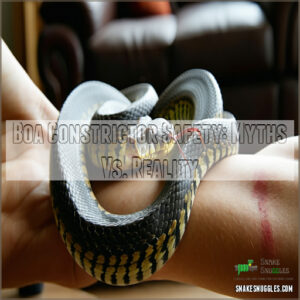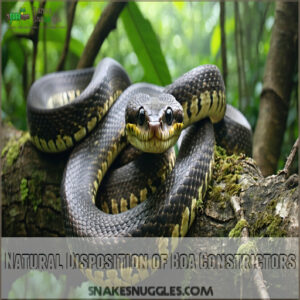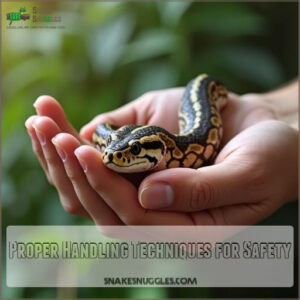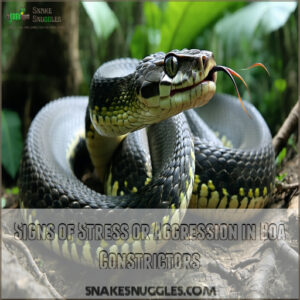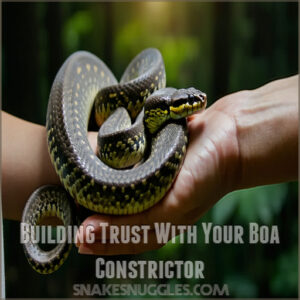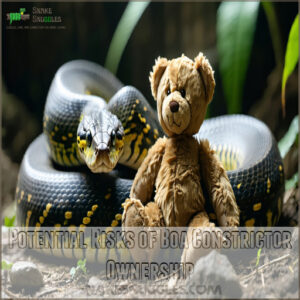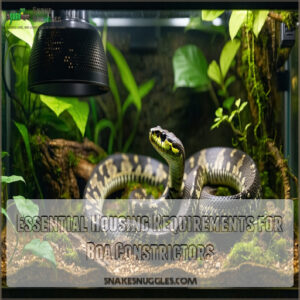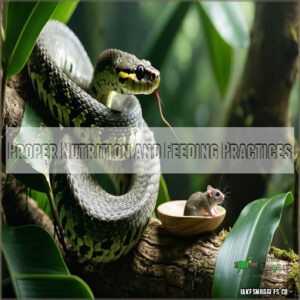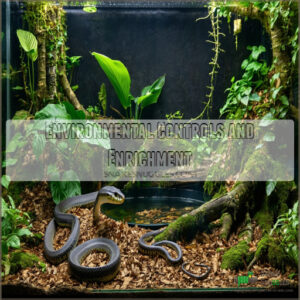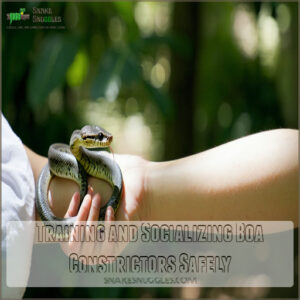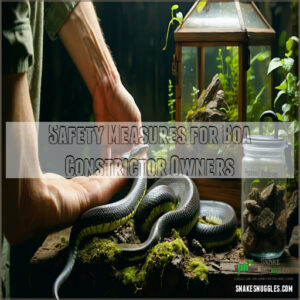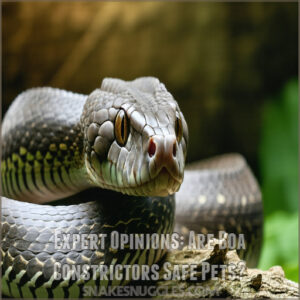This site is supported by our readers. We may earn a commission, at no cost to you, if you purchase through links.
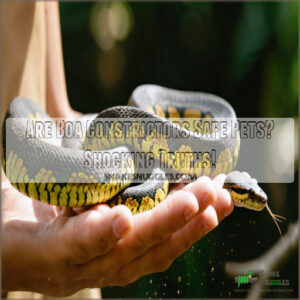
They’re non-venomous, generally calm, and rarely constrict unless provoked.
However, they can grow up to 13 feet long, so secure enclosures and proper handling are a must.
Most bites happen during feeding, not because they’re aggressive.
With regular, gentle handling, they can become quite docile.
They’re easier to care for than some exotic pets, needing less food and space, but their 20-30 year lifespan is a big commitment.
If you’re responsible and pay attention to their behavior, boas can be fascinating, low-maintenance companions.
Ready for the challenge?
Table Of Contents
- Key Takeaways
- Boa Constrictor Safety: Myths Vs. Reality
- Boa Constrictor Temperament and Handling
- Potential Risks of Boa Constrictor Ownership
- Boa Constrictor Care: Ensuring Pet Safety
- Training and Socializing Boa Constrictors Safely
- Safety Measures for Boa Constrictor Owners
- Expert Opinions: Are Boa Constrictors Safe Pets?
- Frequently Asked Questions (FAQs)
- Is it safe to have a boa constrictor as a pet?
- Are boa constrictors friendly to humans?
- Do boa constrictors like to be held?
- What is the friendliest snake as a pet?
- Is it dangerous to own a boa constrictor?
- Is a boa constrictor aggressive?
- Are boa constrictors safe pets?
- Can a boa constrictor be housed with other snakes?
- Are boa constrictors dangerous?
- Are boa constrictors legal?
- Conclusion
Key Takeaways
- They’re generally calm, non-venomous, and low-maintenance, but their size and strength mean you’ll need to handle them responsibly and securely.
- Most risks, like bites or escapes, stem from improper handling or faulty enclosures, so always prioritize safety measures.
- Boa constrictors thrive in secure, well-maintained environments with proper temperature, humidity, and regular feeding schedules.
- Owning one is a long-term commitment; they can live 20-30 years and require consistent care, making them unsuitable for casual pet owners.
Boa Constrictor Safety: Myths Vs. Reality
Are boa constrictors cuddly companions or dangerous predators?
You’ll learn how to separate fact from fiction about boa constrictor safety, so you can decide if these powerful snakes could be good pets.
Common Misconceptions About Boa Constrictor Dangers
Let’s debunk some boa constrictor myths!
They’re not venomous, rarely exceeding 13 feet, and are generally calm.
Forget 20-foot killer snakes!
Proper handling makes them docile pets.
Check this out:
| Myth | Reality | Safety Tips |
|---|---|---|
| Venomous | Non-venomous | No antivenom needed |
| 20-foot monsters | Up to 13 feet | Secure enclosures are essential |
| Aggressive predators | Docile and calm | Gentle handling is key |
| Constrictors always constrict | Constriction is rare | Understand snake behavior |
The information provided helps to understand the true nature of boa constrictors, emphasizing they are not typically aggressive predators.
Documented Incidents Involving Boa Constrictors
Boa constrictor safety is a hot topic, but documented incidents paint a surprising picture.
Over the past five years, actual constrictor attacks and fatal encounters have been remarkably low.
These impressive boa constrictors are native to South America and thrive in rainforest environments.
Let’s examine the data on boa constrictor safety, boa constrictor bites, and constriction risk:
| Incident Type | Number of Cases | Description |
|---|---|---|
| Boa Bites | 12 | Most bites happened during feeding time – think "hand mistaken for tasty rat." Use tongs, folks! This minimizes snake bite pain and risk. |
| Snake Escapes | 7 | Escape incidents usually boil down to faulty enclosures, not Houdini snakes. A secure enclosure is key for boa constrictor safety. |
| Pet Injuries (Human) | 3 | Minor injuries occurred during handling mishaps. Learn the ropes before you wrestle a reptile. |
| Fatal Encounters (Human) | 0 | Zero human fatalities. Yes, zero. This speaks volumes about boa constrictor attacks and constriction risk when you practice proper boa constrictor safety measures. |
This data shows responsible boa owners face minimal risk.
Snakes are more likely to get hurt from clumsy humans than the other way around!
Comparison to Other Exotic Pets
So, how do boa constrictors compare to other exotic pets?
Surprisingly, they’re often easier to care for.
Think of it this way: a sugar glider needs constant playtime, but a boa’s happy in its enclosure.
These non-venomous constrictors, native to Latin America, have established breeding populations in Florida, as detailed on this Florida boa constrictor page.
Here’s a quick look:
| Feature | Boa Constrictor | Other Exotics (e.g., Sugar Glider) |
|---|---|---|
| Space Needs | Low | High |
| Lifespan | Long (20-30 yrs) | Shorter |
| Feeding | Less Frequent | More Frequent |
| Handling | Easier | More Challenging |
Boas offer more stability than many exotic pet options.
Their care is simpler, making them a safer choice for first-time exotic pet owners concerned about pet snake safety.
While boa constrictor bites are possible, understanding boa constrictor safety and exotic pets safety makes responsible ownership achievable.
Factors Influencing Boa Constrictor Behavior
So, you’re curious about what makes a boa tick? It’s a mix of nature and nurture.
Four biggies shape their behavior: genes they’re born with, their home environment, how you handle them, and their health.
Think of it like this:
| Factor | How it Affects Behavior |
|---|---|
| Genetic Influences | Sets their basic personality |
| Environmental Factors | A comfy home keeps them chill |
| Social Learning | Handling teaches them you’re not a threat |
| Hormonal Effects | Like teenagers, hormones make them moody! |
| Brain Structure | How their brain is wired matters, too! |
Understanding these factors helps you raise a happy and safe pet snake.
It’s all about creating a good environment and building trust through gentle handling.
This makes for a calmer boa constrictor temperament and safer interactions for both of you.
Boa Constrictor Temperament and Handling
Understanding a boa constrictor’s temperament is essential for safe handling and building a positive relationship.
You’ll learn how to handle these amazing creatures responsibly and recognize when they’re feeling stressed or uncomfortable, ensuring both your safety and the snake’s well-being.
Natural Disposition of Boa Constrictors
A boa constrictor’s temperament is generally docile, making them surprisingly calm companions.
These snakes are known for their typically calm and curious nature, which contributes to their popularity as safe pet snakes.
While not cuddly like cats, their boa constrictor behavior is usually non-aggressive.
Understanding their constrictor nature and snake temperament is key.
Respect their wild instincts, as even a calm boa constrictor temperament can change if they feel threatened.
This makes understanding boa behavior and their animal personality essential for responsible boa constrictor as pets ownership.
Proper Handling Techniques for Safety
Safe handling builds a strong bond with your boa constrictor.
Here’s your cheat sheet for safe pet snake handling:
- Always use two hands—one near the head, the other mid-body for proper snake support.
- Maintain a gentle touch, allowing natural movement.
- A snake hook is your friend, especially at dinner time.
- Never go solo when handling your boa constrictor.
- Handling precautions: No touchy-feely time for 48 hours after meals.
This is constrictor care 101!
With these safe handling tips and a bit of snake handling safety know-how, you and your boa will be best buds in no time.
Remember, gentle touch and proper snake handling techniques are key to boa constrictor handling.
Signs of Stress or Aggression in Boa Constrictors
Understanding your boa’s stress signals is key for safe handling.
A tense, coiled body, coupled with a raised head, signals a defensive constrictor posture.
Hissing, along with rapid tail movements, is a clear attack warning – back off!
An S-shaped neck? That’s their "ready to strike" pose, so proceed with caution.
Recognizing these aggressive behavior and stress signals guarantees both your safety and your snake’s well-being.
Building Trust With Your Boa Constrictor
Recognizing stress signals paves the way for a stronger bond.
Building trust with your boa constrictor pet takes patience, much like any pet.
Short, gentle handling sessions are key for boa constrictor handling and snake safety.
Start with 5-10 minutes, moving slowly.
Look for constrictor comfort cues like relaxed muscles.
With time and trust exercises, your boa will link your scent to safety.
This builds a solid foundation for safe snake handling and overall pet snake care, ensuring both snake owner safety and boa bonding.
Remember, snake psychology dictates that good relationships with boa constrictor pets develop at their pace.
Potential Risks of Boa Constrictor Ownership
Thinking about getting a boa constrictor? You’ll want to weigh the potential risks of owning one of these powerful snakes, including their size, strength, and potential health concerns.
Size Considerations and Enclosure Security
Boa temperament is key, but a secure enclosure is your first defense against a snake escape.
Consider your boa constrictor size – a large specimen needs a boa constrictor enclosure much larger than a juvenile.
Think at least a 6-foot-long enclosure, sometimes even bigger, for an adult boa constrictor.
Enclosure design matters: secure lids and strong locks are essential for a proper snake enclosure size.
A roomy boa constrictor tank size with appropriate space requirements keeps your boa happy and your home safe, ensuring a proper secure enclosure.
Health Concerns for Owners and Other Pets
Beyond enclosure size, you’ll want to take into account potential health impacts.
Boas can carry salmonella, so wash your hands well after handling.
Pet allergies to boa saliva are also possible.
Regular vet checkups can catch parasitic infections and respiratory infections early.
Here’s a quick rundown:
- Salmonella transmission
- Pet allergies
- Parasite risk
- Respiratory infections
- Bites from stressed boas can pose risks to other pets.
Legal and Liability Issues
Pet-ownership legality involves more than just a cool terrarium.
Knowing your local animal ordinances can prevent legal headaches down the road.
Many regions require specific permits for boa constrictor legality, proof of secure housing for responsible boa ownership, liability insurance, and written agreements with landlords.
Understanding boa constrictor laws is essential for avoiding legal issues and ensuring compliance with regulations.
- Pet Laws vary, so check city, county, and state regulations.
- Liability Insurance protects you if your boa escapes.
- Regulatory Compliance demonstrates responsible pet ownership.
- Animal Ordinances and court precedents shape pet ownership rules.
Boa Constrictor Care: Ensuring Pet Safety
You’ll discover how to create a safe and healthy environment for your boa, covering everything from the right size enclosure to proper feeding.
This knowledge will help you prevent accidents and guarantee your pet thrives under your care.
Essential Housing Requirements for Boa Constrictors
A safe and comfy boa constrictor enclosure starts with a secure vivarium, ideally 6×2 feet for adults.
Prioritize vivarium design and enclosure security to prevent escapes.
For setting up a proper vivarium, consider specialized boa constrictor vivarium resources.
Temperature control is key: maintain a warm side (85-90°F) and a cool side (75-80°F).
Don’t forget humidity management (50-60%).
Substrate options include reptile carpet or bark.
Proper boa constrictor enclosure setup guarantees a happy, healthy snake.
Proper Nutrition and Feeding Practices
A secure home is great, but a well-fed boa is a happy boa.
Prey selection is key: choose frozen-thawed meals about as wide as your snake’s head.
For convenient access to appropriate food, many owners purchase frozen thawed mice online.
Feeding schedules depend on age: young boas eat every 5-7 days, while adults dine every 3-4 weeks.
This supports nutrient balance and maintains digestive health.
No need for supplements with whole prey—it’s nature’s multivitamin!
Health Monitoring and Veterinary Care
A healthy boa means a happy owner!
Beyond proper nutrition, regular health checks are key.
Look out for funky shedding, mouth sores, or wheezing.
Finding a reptile vet (not your dog’s doctor!) is essential for boa constrictor health.
Consider these factors:
- Disease Diagnosis
- Veterinary Costs
- Snake Insurance
- Medical Research on snake health issues.
Catching problems early, like IBD, can save your snake‘s life.
Keep tabs on your boa’s health to avoid those scary boa constrictor health problems.
Environmental Controls and Enrichment
Your boa’s vivarium needs the right setup, think temperature gradients (75-90°F) and humidity levels (50-60%).
Substrate options like cypress mulch create a natural feel, add branches, hides, and a large water dish for humidity control.
For more detailed information, review this thorough boa constrictor pet care guide.
Don’t forget proper ventilation systems and lighting controls—they’re essential for a thriving boa and a balanced vivarium setup, consider heat lamps or undertank heaters for temperature control.
Training and Socializing Boa Constrictors Safely
You can train your boa constrictor through regular handling and positive reinforcement, making them more comfortable around people.
This training creates a safer environment for both you and your snake, reducing the risk of bites or other defensive behaviors.
Early Handling and Socialization Techniques
Building a bond with your boa starts young. Gentle Touch and early introduction are key to successful boa constrictor socialization.
Here’s a simple guide for Youth Training and Handling Tips:
- Start slow, like a first date.
- Short, sweet visits build trust.
- Support their body – they’re not teddy bears.
- Watch for hisses – it’s their way of saying "back off."
- Celebrate small wins – every interaction counts.
| Age | Handling Frequency | Handling Duration |
|---|---|---|
| 0-6 months | 2-3 times a week | 5-10 minutes |
| 6-12 months | 3-4 times a week | 10-15 minutes |
| 1-2 years | 4-5 times a week | 15-20 minutes |
Positive Reinforcement Methods for Boa Constrictors
Early handling builds a solid foundation.
Now, let’s explore reward training.
Positive interaction creates a calm boa constrictor temperament.
Gentle techniques, like offering small prey after handling, build trust.
- Reward calm behavior with treats.
- Use gentle touches, then retreat.
- Keep handling sessions short, sweet, and positive.
- Supervised exploration earns rewards, reinforcing positive interaction.
This improves boa behavior and makes snake handling safer, which is the result of gentle techniques.
Setting Boundaries and Establishing Routines
A predictable routine is key for responsible boa ownership.
Regular handling builds trust, but respect their space.
Don’t handle after meals.
A gentle tap signals handling time.
| Time of Day | Activity | Owner Responsibility |
|---|---|---|
| Evening | Handling | Gentle handling techniques |
| 10-14 Days | Juvenile Feeding | Safe handling |
| 3-4 Weeks | Adult Feeding | Introduction and socialization |
The table outlines specific times for handling and feeding, ensuring a clear schedule for boa care.
Safely Introducing Boa Constrictors to New Environments
Moving a boa constrictor to a new home doesn’t have to be a wrestling match. Think of it as helping your scaly friend settle into a new pad. You want the shift to be as smooth as possible, so replicate their old digs in the new environment.
Here’s your moving checklist:
- Match the temperature and humidity of their old terrarium. Think Goldilocks – not too hot, not too cold, but just right.
- Move their familiar furniture – hides, water bowl, branches – before introducing your boa. It’s like having their favorite comfy chair waiting for them.
- Keep a close eye on your boa for any signs of stress, like hiding more than usual or skipping meals.
Patience is key. Let your boa explore and adjust at their own pace.
Safely handling your boa during this introduction and socialization period will reduce stress and aid in environmental acclimation. Focus on habitat design and snake transportation that minimizes disruption. Implementing these introduction techniques contributes to stress reduction and responsible boa ownership. With a little planning and these escape prevention strategies, your boa will be chilling in their new crib in no time.
Safety Measures for Boa Constrictor Owners
You’ll learn essential safety measures for boa constrictor owners, covering everything from proper handling to preventing escapes.
These tips will help you keep both yourself and your snake safe and sound.
Personal Protective Equipment for Handling
When handling a boa constrictor, gear up like a pro.
Thick gloves offer solid protection, while arm guards and long sleeves shield against accidental scratches.
Snake hooks help maintain safe distance, especially with nervous boas.
Safety goggles? A smart move to avoid strikes near your face.
Handling towels can also provide extra grip.
Specialized boa handling gloves offer enhanced grip and protection.
Even calm snakes can surprise you—stay ready with safety goggles.
Emergency Protocols for Potential Escapes
Mistakes happen, and even the best snake enclosure isn’t foolproof.
If your boa constrictor escapes, stay calm and act fast.
Your emergency response plan matters.
Keep a snake capture kit ready—snake hooks, gloves, and a sturdy container.
Know your pet snake’s habits and favorite spots.
Search room by room, block exits, and alert neighbors.
For serious situations, contact local reptile experts or animal control immediately.
Understanding boa handling techniques is essential in safely capturing and handling your escaped boa constrictor.
Safe Interaction Guidelines for Family and Visitors
After prepping for escapes, focus on Visitor Safety Tips and Family Interaction with your pet snake.
Keep kids supervised—no solo handling allowed. Visitors? Short, guided demos only. Always support the snake’s body and watch for stress signals.
Follow these Household Precautions:
- Never let children handle unsupervised.
- Limit visitor interactions.
- Watch for snake behavior changes.
- Prioritize everyone’s safety, including the boa’s.
Proper Cleaning and Sanitation Practices
Keeping your boa constrictor’s enclosure clean is key to snake health and your safety.
Use reptile-safe cleaning supplies and sanitize monthly with proper disinfecting techniques.
Refresh water daily, replace substrate quarterly, and follow strict hygiene protocols like wearing gloves.
A clean habitat prevents diseases and promotes animal welfare.
Here’s a quick guide:
| Task | Frequency | Tools Needed |
|---|---|---|
| Disinfect enclosure | Monthly | Reptile-safe cleaner |
| Refresh water | Daily | Clean water bowl |
| Replace substrate | Quarterly | Gloves, fresh bedding |
| Spot-clean waste | Weekly/as needed | Dedicated brushes |
A healthy boa equals a happy owner!
Expert Opinions: Are Boa Constrictors Safe Pets?
You’ve probably wondered if experts think boa constrictors are truly safe pets.
Let’s look at what herpetologists, veterinarians, and experienced keepers have to say about their behavior, care, and risks.
Herpetologist Perspectives on Boa Constrictor Safety
Herpetologists agree that boa constrictors are safe pets when you understand their behavior.
These snakes aren’t out to get you—they’re calculated and predictable, often giving clear signs if stressed.
- Watch for signals: Hissing or striking means it’s feeling defensive.
- Provide a calm environment: Noise and vibrations can agitate them.
- Handle with care: Support their body, avoid sudden moves.
Snake behavior is all about reading the cues!
Veterinary Insights on Boa Constrictor Pet Ownership
Veterinary guidance is key to boa constrictor care.
Regular check-ups help spot issues like IBD or respiratory infections early.
A reptile vet should assess your pet snake’s muscle tone, skin, and overall health every 6-12 months.
Following reptile care guidelines is essential for maintaining a healthy boa constrictor.
Here’s a quick breakdown:
| Boa Health Risks | Signs to Watch | Vet Tips |
|---|---|---|
| Respiratory infections | Wheezing, open-mouth breathing | Maintain proper humidity |
| Scale rot | Discolored, damaged scales | Keep enclosure clean |
| Inclusion Body Disease (IBD) | Lethargy, poor appetite | Immediate vet visit |
Your boa’s welfare depends on proactive care and understanding of potential health risks, such as respiratory infections.
Experienced Keeper Testimonials and Advice
Experienced boa keepers have a lot to teach about understanding these fascinating snakes.
According to Tom Richards, a 20-year boa owner, “They’re not the villains people imagine. Learn their body language, and you’ll see they’re surprisingly predictable.”
Here’s what seasoned keepers recommend:
- Be patient: Building trust takes time, but it’s worth it.
- Stick to a routine: Regular handling helps boas stay calm and familiar with you.
- Know their quirks: Each snake has its own temperament—some are shy, others bold.
With consistent care and respect, boa constrictors can be safe, rewarding pets.
Regulatory Views on Boa Constrictors as Pets
Wondering if boa constrictors are legal pets in your area?
The regulatory framework for owning exotic pets like these snakes varies widely.
Some places require permits, while others ban them outright.
Check local regulations, including animal control rules and government regulations, before joining the pet trade.
Staying on top of exotic pet policies guarantees you’re in the clear—and keeps you and your pet snake out of trouble!
Frequently Asked Questions (FAQs)
Is it safe to have a boa constrictor as a pet?
Boa constrictors can be safe pets if you’re responsible.
They’re calm, but their size means proper handling, secure enclosures, and supervision are essential.
Never leave them with kids or small pets, and always prioritize safety.
Are boa constrictors friendly to humans?
They’re not exactly “friendly” like a dog, but boa constrictors are typically calm and tolerate handling well if they’re used to it.
Just watch for stress signals, and never leave them unattended with kids.
Do boa constrictors like to be held?
Don’t worry, boa constrictors don’t mind being held if you handle them properly.
They’re usually calm and enjoy the warmth of your hands.
Just support their body, avoid sudden moves, and they’ll feel secure.
What is the friendliest snake as a pet?
Corn snakes are often considered the friendliest pet snakes.
They’re calm, easy to handle, and rarely bite.
Plus, they’re low-maintenance, come in stunning colors, and stay a manageable size—perfect for beginners or experienced owners alike.
Is it dangerous to own a boa constrictor?
Owning a boa constrictor isn’t inherently dangerous if you’re responsible.
They’re generally calm, but their size means mishandling or neglect could cause harm.
Learn proper care, handle safely, and never leave them unattended with kids.
Is a boa constrictor aggressive?
Boa constrictors aren’t usually aggressive; they’re more chill than you’d expect.
But if they’re scared, hungry, or feel threatened, they might hiss or strike.
Handle them gently, and you’ll likely avoid any drama.
Are boa constrictors safe pets?
Boa constrictors can be safe pets if you’re responsible.
They’re generally calm and low-maintenance, but their size and strength mean careful handling, secure enclosures, and proper care are essential.
Never leave kids unsupervised with them.
Can a boa constrictor be housed with other snakes?
Snake sharing sounds simple, but it’s risky.
Boa constrictors thrive solo since housing them with others can lead to stress, competition, or injuries.
Stick to separate enclosures to keep everyone safe and stress-free.
Are boa constrictors dangerous?
They’re not inherently dangerous but can be if mishandled or startled.
Their strength can harm small pets or children, and bites happen if they feel threatened.
Handle responsibly, support their body, and stay alert.
Are boa constrictors legal?
Don’t worry, boa constrictors can be legal, but it depends on where you live.
Some places require permits or ban them outright.
Always check your local laws before bringing one home to avoid trouble.
Conclusion
So, are boa constrictors safe pets? They can be, but only if you’re ready to meet their needs.
These snakes are calm and fascinating, but their size, lifespan, and care requirements aren’t for everyone.
With proper handling, secure enclosures, and attention to their behavior, they’re low-maintenance companions compared to other exotic pets.
Just remember, owning one is a big responsibility. If you’re up for the challenge, a boa constrictor might just be the right pet for you.
- https://www.floridamuseum.ufl.edu/florida-snake-id/snake/boa-constrictor/
- https://animals.mom.com/children-safe-around-boa-constrictors-2270.html
- https://www.reddit.com/r/snakes/comments/b9oe2v/do_boa_constrictors_make_good_beginner_pets/
- https://reptifiles.com/boa-constrictor-care/boa-constrictor-handling/
- https://www.itis.gov/servlet/SingleRpt/SingleRpt?search_topic=TSN&search_value=174321

